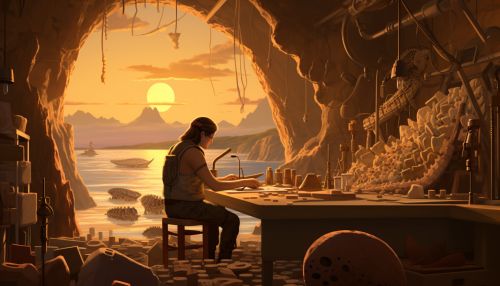Paleobiology
Introduction
Paleobiology is a scientific discipline that combines the methods and findings of the natural science biology with the methods and findings of the earth science paleontology. It is occasionally referred to as "geobiology". Paleobiological research uses biological field research of current biota and of fossils millions of years old to answer questions about the molecular evolution and the evolutionary history of life.
History
The term "Paleobiology" was coined in the early 20th century, though the discipline itself has a much longer history, tracing its origins to the work of Lamarck and Darwin in the 19th century. The field began to mature in the 1950s with the advent of paleoecology, which sought to reconstruct the environments of extinct organisms, and biogeography, the study of the distribution of organisms in space and time.
Methodology
Paleobiologists use various techniques and approaches. They use traditional paleontological techniques to uncover the fossil record and then apply comparative anatomical methods to interpret the morphology of ancient organisms. They also use experimental and observational techniques from biology to test hypotheses about the functional and ecological significance of morphological features.


Major Topics
Evolutionary Theory
One of the major topics in paleobiology is evolutionary theory. Paleobiologists use the fossil record to understand the processes and patterns of evolution over deep time. They study how different species have evolved over millions of years and how the environment has influenced this evolution.
Extinction Events
Another major topic of study in paleobiology is extinction events. These are periods in Earth's history when a significant portion of life forms died out, such as the end-Permian extinction event and the Cretaceous-Paleogene extinction event that led to the extinction of the dinosaurs.
Paleoenvironments
Paleobiologists also study paleoenvironments, which are reconstructions of ancient environments. They use evidence from the fossil record to understand the climate, geography, and biota of the past.
Biodiversity
Biodiversity over geological time is another major topic in paleobiology. Paleobiologists study how biodiversity has changed over time, including periods of rapid diversification and mass extinction.
Impact
Paleobiology has had a profound impact on our understanding of life's history and evolution. It has provided evidence for the theory of evolution, shed light on the causes and consequences of mass extinctions, and helped us understand the past climates of Earth.
See Also
Categories
References
- Benton, M. J. (2009). Paleobiology and beyond: it's not just stamp collecting. Biology Letters, 5(3), 265-267.
- Briggs, D. E., & Crowther, P. R. (Eds.). (2008). Palaeobiology II. John Wiley & Sons.
- Sepkoski, D. (2012). Rereading the Fossil Record: The Growth of Paleobiology as an Evolutionary Discipline. University of Chicago Press.
